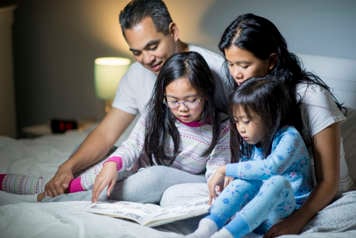What are sleep problems?
Sleep problems occur when your child has difficulty falling asleep or staying asleep. They can also include episodes of sleep interruption which can impact on your child’s restfulness and lead to disrupted sleep for other members of the household. Helping your child fall asleep and stay asleep are important parts of healthy sleep patterns and lead to better rest.
Types of sleep problems
Difficulty settling down to sleep
It is very common for babies, toddlers and young children to have trouble falling asleep. Most people fall asleep more easily when they are tired and relaxed while following a regular routine. Babies and children are no different. The best sleep environment is familiar, inviting, dark or dimly lit, and quiet. Older babies and toddlers may resist bedtime despite being tired and may need their routine reinforced. Crying at bedtime is a common behaviour in this age group. Some children have difficulty falling asleep because they have a sleep habit that relies on someone or something, such as a milk bottle or being rocked to sleep. The approach to helping them fall asleep more easily is to reinforce a routine that allows a child to self-soothe instead and removes habits that can lead to other health problems. Milk bottles or juice given in bed, for example, are not recommended due to the risk of dental caries. Older babies should finish their bottle before being placed drowsy but awake in their crib and toddlers should cease all bottle use by 18 months. When sleep routines change to improve sleep patterns, many children need to learn how to fall asleep on their own. There are different approaches to sleep training for older babies and toddlers who have difficulty settling down to sleep. The approach that you choose is up to you.
Night awakening and parasomnias
Night awakenings occur when a child wakes up in the middle of the night and cannot settle back to sleep. Often the child will cry or call out for their parents or get out of bed. This is common. Many children will wake more often when they are sick or when their routine is disrupted. Think about how you sleep when you are away from your regular bed or when you have a cough or congestion. Children are no different. Change in routine, travel or illness can temporarily affect your child’s sleep.
Other children have never learned how to fall asleep on their own and cannot self-soothe and fall back to sleep if they do wake up at night. The first steps in reducing sleep interruptions involve establishing a bedtime routine so that your child learns to soothe and fall asleep and identifying any causes of nighttime waking. For example, an older baby who is given a milk bottle in bed to fall asleep at bedtime may wake up in the middle of the night and cry for milk. Since the milk bottle is their habit that they rely on to fall back to sleep, those children need to learn how to self-soothe to fall back to sleep without a bottle. Removing the milk bottle from sleep routines both at bedtime and in the middle of the night is a necessary step in reducing sleep interruptions.
Some children can wake up in the middle of the night due to a nightmare. Nightmares are dreams that bring about fear or anxiety and are common, but generally do not occur every night or multiple times in a night. Children who wake up from a nightmare can be reassured and comforted so that they can fall back to sleep.
A parasomnia is the term used to describe an unusual behaviour during sleep. Some parasomnias are very common in children, including night terrors, sleep talking, sleepwalking and confusional arousal. Except for sleepwalking (which may require safety planning), other childhood parasomnias do not require any intervention and many children outgrow them. Children who experience parasomnias are generally not awake or fully aware and need to be gently directed back to bed without being woken up.
Night terrors are different from nightmares. Night terrors are characterized by a child appearing to waken in horror. The child often thrashes and screams in panic but is usually not fully aware or awake. Children with night terrors will fall back to sleep and will not remember the event in the morning. It is more common in school-aged children.
Sleep talking is extremely common in children. Like night terrors, children who sleep talk are not awake, but their talking can certainly wake others and lead to disrupted sleep in the household.
Sleepwalking occurs in about 15 per cent of all children. It occurs most often in children aged four to 12 years. Sleepwalking children usually walk around the house aimlessly, but they may move furniture or try to leave the house. They appear uncoordinated, may speak without making sense or start urinating in some place other than the toilet. If your child sleepwalks, it is important to ensure that the environment remains safe. A bell hung on the child’s door or on the front door may provide reassurance that you will hear your child sleepwalking.
Confusional arousal is more common in pre-school aged children and also occurs in about 15% of children. Children will sit up in bed, appear confused, partially awake and go back to sleep.
How to help your child
There are many ways to help your child or teen establish healthy sleep habits. Understanding the factors that are contributing to your child’s sleep problem is important. These causes may vary based on age and on your child’s schedule.
If you are concerned about your child’s sleep pattern or sleep behaviours, try these sleep tips for children and teens. If they do not improve your child’s sleep pattern, ask for help from your child’s health-care provider. There are many approaches to sleep training for older babies and toddlers who have disrupted sleep. The approach that you choose is up to you.
